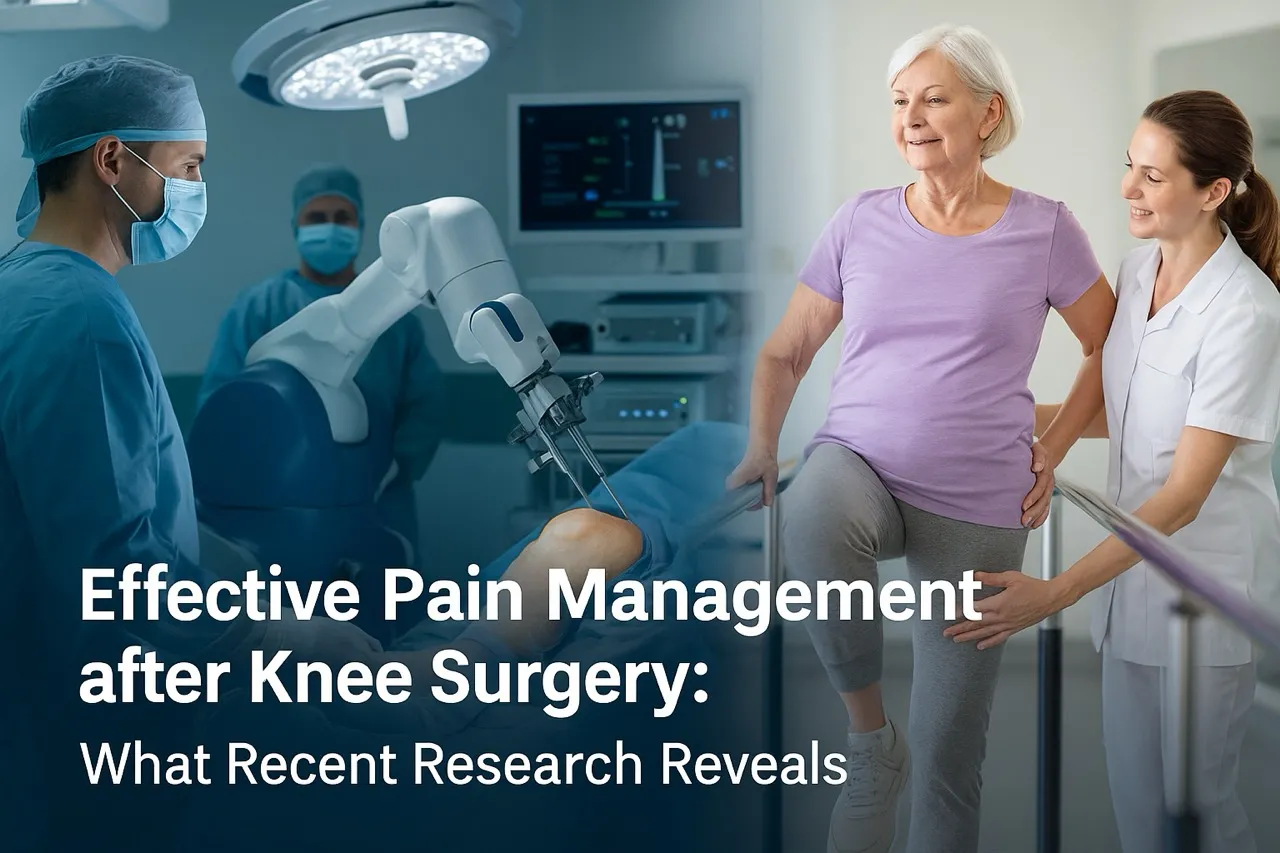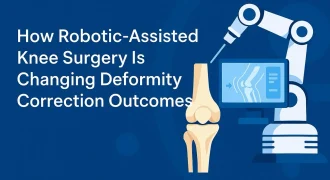Table of Contents
Recovering from knee surgery can be a challenging journey — especially during the first few days when pain, stiffness, and limited mobility can affect both comfort and rehabilitation. Modern surgical techniques have advanced significantly, but equally important are the post-operative pain management strategies that ensure faster recovery and better long-term results.
Recent research has introduced targeted pain control methods, especially for patients with deformities or complex knee reconstructions, that minimize discomfort while helping patients walk sooner.
At deformity.co.in, under the expertise of Dr. Divya Ahuja — one of the best Ilizarov surgeons in Mumbai and India, pain management after knee surgery is not an afterthought; it’s an integral part of the recovery plan.
Understanding Modern Pain Management after Knee Surgery
In the past, pain control after knee surgery relied mainly on opioid medications and generalized nerve blocks. While effective to some extent, these approaches often came with side effects such as drowsiness, nausea, or delayed rehabilitation.
Recent advances focus on:
- Targeted nerve blocks that numb only the pain-carrying nerves while preserving muscle strength.
- Localized infiltration techniques that reduce pain right at the surgical site.
- Multimodal analgesia — combining different types of pain relief to minimize opioid use and speed up recovery.
This shift towards precision pain management enables patients to initiate mobilization earlier, engage more effectively in physiotherapy, and experience overall smoother rehabilitation.
Hover (desktop) or tap (mobile) each day to reveal actions. Built around ACB + PCI + multimodal protocols to control pain and preserve mobility.
Benefits of Adductor Canal Block and Posterior Capsular Infiltration
Two of the most promising techniques for post-knee surgery pain management are the Adductor Canal Block (ACB) and Posterior Capsular Infiltration (PCI). Both are supported by strong clinical research for their efficacy and safety.
Adductor Canal Block (ACB)
The adductor canal is a passage in the middle thigh that carries the saphenous nerve, which is responsible for sensation around the knee, not muscle strength. By selectively blocking this nerve:
- Patients experience excellent pain relief in the front and inner knee.
- Quadriceps strength is preserved, unlike older femoral nerve blocks.
- This allows for early ambulation, which is crucial for preventing stiffness and complications, such as deep vein thrombosis.
Recent research shows that patients receiving ACB walk sooner and need less systemic pain medication compared to traditional blocks.
Posterior Capsular Infiltration (PCI)
While ACB controls pain on the front and sides of the knee, posterior capsular infiltration targets the back of the knee, which is often a hidden source of discomfort after surgery.
By injecting local anesthetics and sometimes anti-inflammatory agents into the posterior capsule:
- Residual deep pain is significantly reduced.
- Patients report better comfort during physiotherapy and night-time rest.
- Combining PCI with ACB offers comprehensive pain coverage without affecting muscle control.
Clinical studies in the last 5 years confirm that the ACB + PCI combination is more effective than ACB alone for total knee replacement and deformity correction surgeries.
How Effective Pain Control Improves Mobility & Rehabilitation in Deformity Cases
For patients undergoing complex knee deformity correction (such as with Ilizarov techniques or robotic-assisted procedures), early mobility is crucial for:
- Preventing joint stiffness
- Promoting better alignment outcomes
- Reducing post-operative complications
- Shortening hospital stay
Without proper pain management, patients often delay physiotherapy or limit participation, leading to slower functional recovery.
By integrating ACB + PCI + multimodal pain protocols, surgeons like Dr. Divya Ahuja help patients:
- Walk within hours to a day post-surgery
- Participate actively in rehabilitation programs
- Return to normal activities more confidently
This is especially valuable in deformity cases, where precision alignment and weight-bearing need to happen in a controlled but timely manner.
Practical Tips for Managing Pain During Recovery
While medical pain control is essential, patients can also play a role in making their recovery smoother. Here are a few practical pain management tips for the post-operative period:
1. Follow the Medication Schedule
Don’t wait for pain to become severe before taking prescribed medication. Staying ahead of pain improves comfort and mobility.
2. Use Cold Therapy Effectively
Applying cold packs or cryotherapy devices reduces swelling and pain, especially in the first 48–72 hours.
3. Elevate and Support Your Leg
Keeping the operated leg slightly elevated helps reduce fluid accumulation and discomfort.
4. Stay Consistent with Physiotherapy
Gentle guided exercises help maintain mobility and prevent stiffness. Skipping sessions can prolong pain and recovery.
5. Communicate with Your Surgical Team
Report pain that doesn’t improve with medication or worsens at night. Early adjustments to the pain regimen can prevent complications.
Services and Patient Support By Dr. Divya Ahuja
At deformity.co.in, pain management protocols are personalized for each patient.
Led by Dr. Divya Ahuja, one of India’s leading Ilizarov and limb reconstruction surgeons, the center offers:
- Advanced regional anesthesia techniques (ACB, PCI)
- Multimodal pain protocols tailored to deformity correction cases
- Close coordination between surgeons, anesthetists, and physiotherapists
- Continuous patient support through recovery — both in-clinic and virtually
Patients benefit from a smooth, well-coordinated recovery plan, ensuring they return to mobility faster and with less discomfort.
Our Clinical Locations
Tap a location to view timings, contact, and map.
Broadway Healthcare, Dadar East
Broadway Healthcare, Dadar East
Clinic Info
- 📍 Broadway Healthcare, Dadar East, Mumbai
- 🕒 Wednesdays · 10:00 AM – 12:00 NOON
- 📞 Appointments: +91 93213 17227
Sweet Clinics, Vashi, Navi Mumbai
Sweet Clinics, Vashi, Navi Mumbai
Clinic Info
- 📍 Sweet Clinics, Vashi, Navi Mumbai
- 🕒 Fridays · 10:00 AM – 12:00 NOON
- 📞 Appointments: +91 93213 17227
Heal Well Speciality Clinic, Thane West
Heal Well Speciality Clinic, Thane West
Clinic & OPD Info
- 📍 Heal Well Speciality Clinic, Thane West
- 🕒 Every Wednesday 10:00 AM – 11:00 AM
- 📞 Appointments: +91 81691 04438
Mangal Anand Hospital, Chembur Mumbai
Mangal Anand Hospital, Chembur Mumbai
Clinic & OPD Info
- 📍 Mangal Anand Hospital, Chembur Mumbai
- 🕒 Monday, Wednesday, Friday 03-07 PM, Thursday 06-07 PM, Free OPD Saturday 02-04 PM
- 📞 Appointments: +91 70212 18182
Conclusion
Effective pain management after knee surgery isn’t just about comfort — it’s about accelerating recovery, improving mobility, and ensuring long-term surgical success.
Techniques like Adductor Canal Block and Posterior Capsular Infiltration, when applied thoughtfully, can transform the post-op experience for patients, especially those undergoing deformity correction procedures.
Under the expert care of Dr. Divya Ahuja, one of the best Ilizarov surgeons in Mumbai and India, patients receive world-class surgical precision and recovery protocols that match international standards.
To learn more or book a consultation, visit deformity.co.in.
FAQs
What is the most effective pain management technique after knee surgery?
The combination of Adductor Canal Block and Posterior Capsular Infiltration with multimodal analgesia has shown the best balance of pain relief and preserved mobility in recent studies.
Does advanced pain management reduce hospital stay?
Yes. Patients receiving targeted pain blocks usually walk earlier, have fewer complications, and often go home sooner compared to traditional methods.
Are these techniques safe?
Both ACB and PCI are well-researched and safe, with minimal risk of muscle weakness or systemic side effects compared to older nerve blocks.
How long does the pain relief last after these blocks?
Typically, the effects last 12–24 hours, and are often supplemented with oral or IV pain medications to extend comfort during the first few days.
Why is pain management extra important in deformity correction cases?
Because mobility, alignment, and weight-bearing are critical post-surgery. Better pain control → earlier physiotherapy → faster, more accurate recovery.









